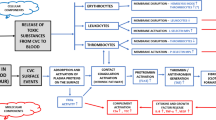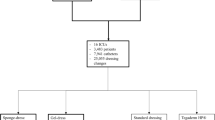Abstract
To study the inhibitory effects on bacterial adhesion of a newly devised, hydrophilic heparinized catheter to be used in patients with malignant obstructive jaundice, a randomized controlled study of indwelling endoprostheses was performed, using implantable port-connected heparinized catheters (n=25) and silicone catheters (n=21). Catheters with-drawn from patients were cultured for bacteria and examined by electron microscopy for the presence of adherent organisms. In vitro examination of the two type of catheters exposed to suspensions ofEschericia coli andStaphylococcus aureus was performed using electron microscopy and a luminometer. The formation of a biofilm coated with glycocalyces was found in silicone catheters, but not in the heparinized catheters. In vitro experiments demonstrated little bacterial adhesion to the heparinized surface, but significant formation of biofilm on the silicone surface. Anionically charged heparinized catheters have inhibitory effects on bacterial adhesion, and the surface charge of the catheter may be a factor in inhibiting this adhesion.
Similar content being viewed by others
References
Glenn F, Evans JA, Mujahed Z, et al. Percutaneous transhepatic cholangiography. Ann Surg 1962;156:451–462.
Kaude JV, Weidenmier CH, Agee OF. Decompression of bile ducts with the percutaneous transhepatic technique. Radiology 1969;93:69–71.
Molnar W, Stockum AE. Relief of obstructive jaundice through percutaneous transhepatic catheter: A new therapeutic method. Am J Roentgerol 1974;122:356–367.
Cotton PB, Burney PGJ, Mason RR. Transnasal bile duct catheterization after endoscopic sphinctectomy. Gut 1979;20:285–287.
Huibregtse K, Haverkamp HJ, Tytgat GN. Transpapillary positioning of a large (3.2-mm) biliary endoprosthesis. Endoscopy 1981;13:217–219.
Siegel JH, Pullano W, Kodsi B, et al. Optimal palliation of malignant bile duct obstruction; Experience with endoscopic 12-French prostheses. Endoscopy 1988;20:137–141.
Molin O, Nilsson L, Ansehn S. Rapid detection of bacterial growth in blood cultures by bioluminescent assay of bacterial ATP. J Clin Microbiol 1983;18:521–525.
Mueller PR, van Sonnenberg E, Ferrucci Jr JT. Percutaneous biliary drainage: Technical and catheter-related problems in 200 procedures. Am J Roentgerol 1981;138:17–23.
Speer AG, Cotton PB, Rode J, et al. Biliary stent blockage with bacterial biofilm. Ann Intern Med 1988;108:546–553.
Sung JY, Leung JWC, Snaffer NA, et al. Bacterial biofilm, brown pigment stone and blockage of biliary stents. J Gastroenterol Hepatol 1993;8:28–34.
Costerton JW, Cheng KJ, Geesey GG, et al. Bacterial biofilms in nature and disease. Ann Rev Microbiol 1987;41:435–464.
Nagaoka S, Mikami M, Noishiki Y. Evaluation of antithrombogenic thermodilution catheter. J Biomat Appl 1989;4:22–32.
Speer AG, Russell RCG, Hatfield ARW, et al. Randomized trial of endoscopic versus percutaneous stent insertion in malignant obstructive jaundice. Lancet 1987;II:57–62.
Hoevels J, Ihse I. Percutaneous transhepatic insertion of a permanent endoprosthesis in obstructive lesions of the extrahepatic bile ducts. Gastrointest Radiol 1979;134:367–377.
Yamakawa T, Esquerra RD Jr, Kaneko H. Percutaneous endoprosthesis in malignant obstruction of the bile duct. World J Surg 1988;12:78–84.
Dooley JS, Dick R, George P, Kirk RM, et al. Percutaneous transhepatic endoprosthesis for bile duct obstruction. Complications and results. Gastroenterology 198;86:905–909.
Lammar J, Neumayer K. Biliary drainage endoprosthesis: Experience with 201 placements. Radiology 1986;159:625–629.
Mueller PR, Ferrucci JT, Teplick SK, et al. Biliary stent endoprosthesis; analysis of complications in 113 patients. Radiology 1985;156:637–639.
Coons HG. Self-expanding stainless steel biliary stents. Radiology 1989;170:979–983.
Fletcher M, Loeb GL. Influence of a marinePseudomonas to solid surface. Appl Environ Microbiol 1979;37:67–72.
Pashley RM, McGuiggan PM, Ninham BW. Attractive forces between uncharged hydrophobic surfaces: Direct measurements in aqueous solution. Science 1985;229:1088–1089.
Skar V, Skar AG, Midtvedt T, et al. Bata-glucuronidase-producing bacteria in bile from the common duct in patients treated with endoscopic papillotomy for gallstone disease. Scand J Gastroenterol 1986;21:253–256.
Author information
Authors and Affiliations
Rights and permissions
About this article
Cite this article
Homma, H., Nagaoka, S., Mezawa, S. et al. Bacterial adhesion on hydrophilic heparinized catheters, with compared with adhesion on silicone catheters, in patients with malignant obstructive jaundice. J Gastroenterol 31, 836–843 (1996). https://doi.org/10.1007/BF02358611
Received:
Accepted:
Issue Date:
DOI: https://doi.org/10.1007/BF02358611




